Utagawa Kunisada
1786 ~ 1865Kunisada was born in the Honjo district of Edo as Kunisada Tsunoda, into a family that owned a hereditary ferry service. He showed significant promise
in painting and drawing from a young age, thanks in part to his family`s connections with literary and theatrical circles.
At the age of 15, he became a pupil of Toyokuni I of the Utagawa school, later adopting his master`s name in 1844 to become Toyokuni III.
Throughout his career, Kunisada specialized in ukiyo-e prints, focusing on traditional subjects such as kabuki, bijin (beautiful women), shunga (erotic prints), and historical scenes.
His works reflect the culture of Japan in the years leading up to the country`s opening to the West.
He was incredibly prolific, with his output including nearly 20,000 prints, illustrated books, and other privately commissioned works, earning him a reputation that surpassed contemporaries
like Hokusai and Hiroshige.
Kunisada was particularly renowned for his portraits of kabuki actors (yakusha-e) and depictions of beautiful women, often courtesans from the Yoshiwara district. He collaborated with the author
Ryūtei Tanehiko to illustrate a series of books based on the classic novel "The Tale of Genji," moving the setting from the old capital of Kyoto to Edo. This project started the new ukiyo-e genre
of Genji-e (源氏絵) and became a phenomenal success, being the first Japanese publication to sell over 10,000 copies.
Despite his fame in 19th century Japan, Kunisada`s reputation among Western collectors remained low until the 1990s, when his work was reevaluated through intensive studies.
Kunisada died in 1864 in the neighborhood where he was born, at the age of 70, leaving a lasting legacy as one of the most active and popular ukiyo-e masters. Notable students of Kunisada included Kunichika
Toyohara, Utagawa Sadahide, and Kunisada II.
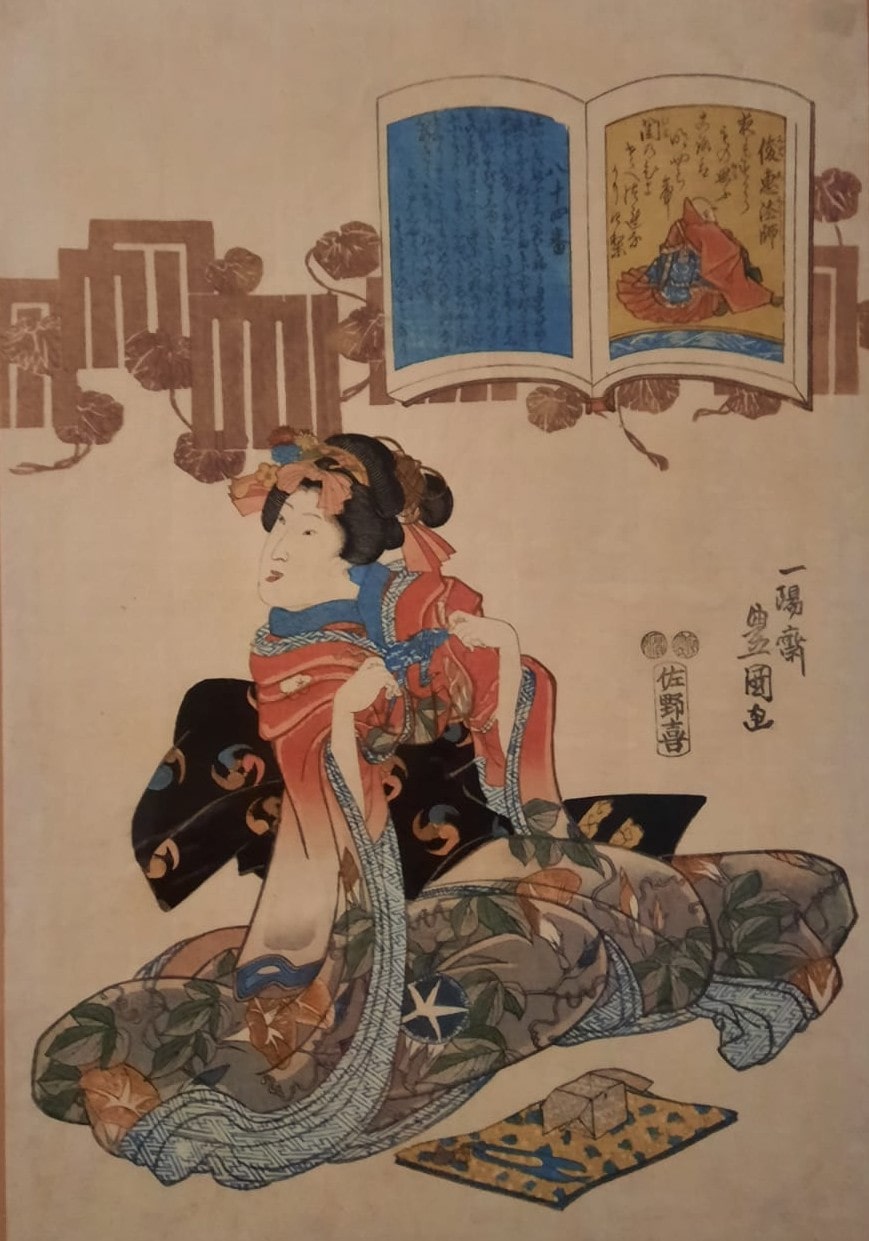 Not for Sale
Not for Sale
A beauty, perhaps a courtesan playing with paper sheets and folidng few origami.
Her garment are rich in color and design. An unfolded book in the upper right corner reveals the eighty fourth poem from the one hundred poems anthology with a miniature of its author on the right page, while
a commentary to it is on the left one.
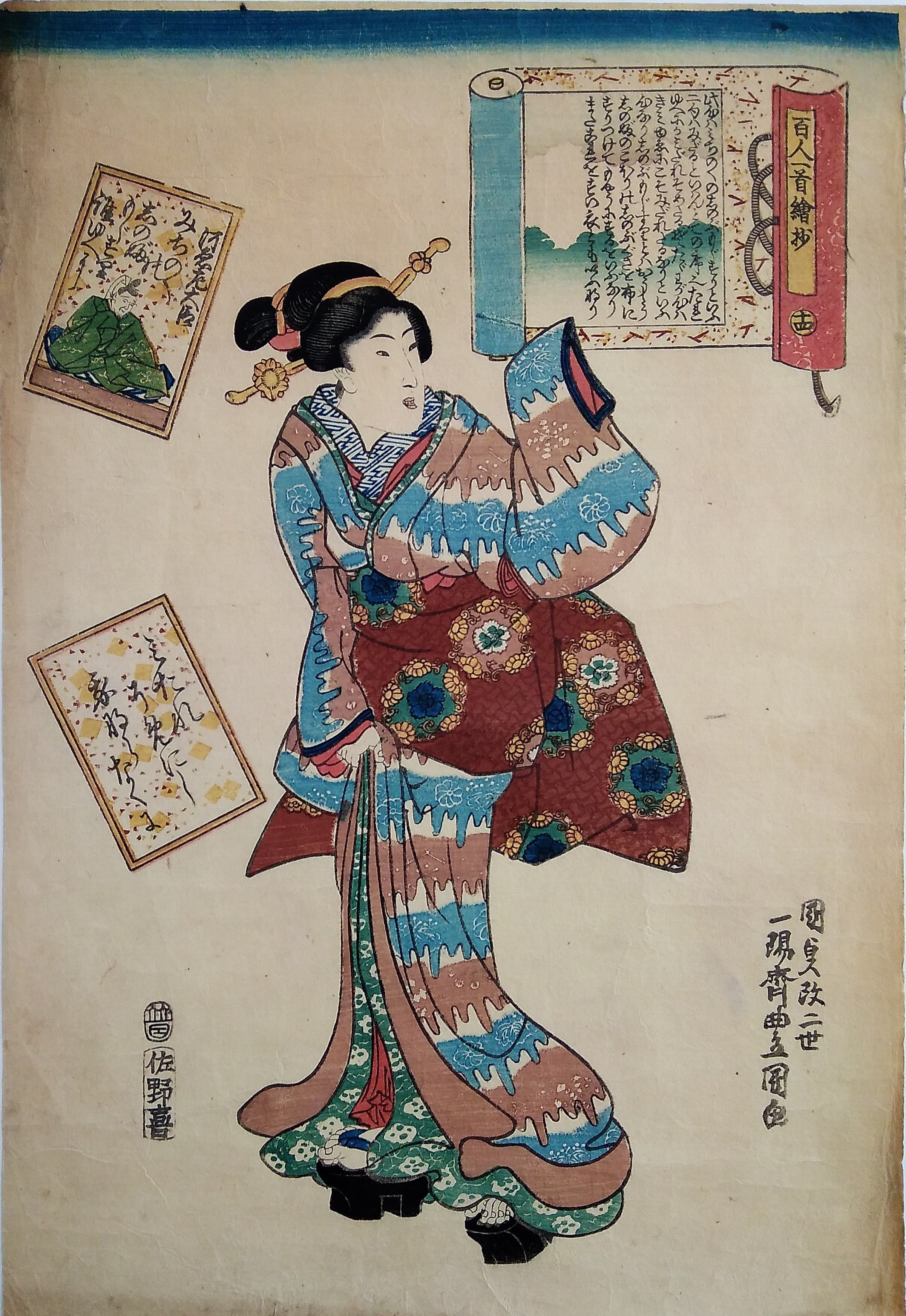 Sold Out
Sold Out
A beauty dressed in a garment rich in colour and design. To her left, two cards reveal the fourteenth poem from the "Hyakunin Isshu" (Anthology of One Hundred Poets)
along with a miniature portrait of its author. In the upper right corner, an unfolded scroll displays commentary on the poem.
Here is an approximate translation of the poem:
"陸奥の しのぶもぢずり 誰ゆゑに 乱れそめにし 我ならなくに。"
"Michinoku no Shinobu mojizuri Tare yue ni Midare some ni Ware naranaku ni."
Like the hidden patterns on Shinobu-dyed cloth from distant Michinoku,
Why have my feelings become so tangled?
It was not of my own doing.
Censor and publisher seals are visible on the left, one above the other. On the right, the artist signs as Kunisada aratame nidai Ichiyōsai Toyokuni ga (国貞改二代一齊豊国画), a signature he often used after 1844.
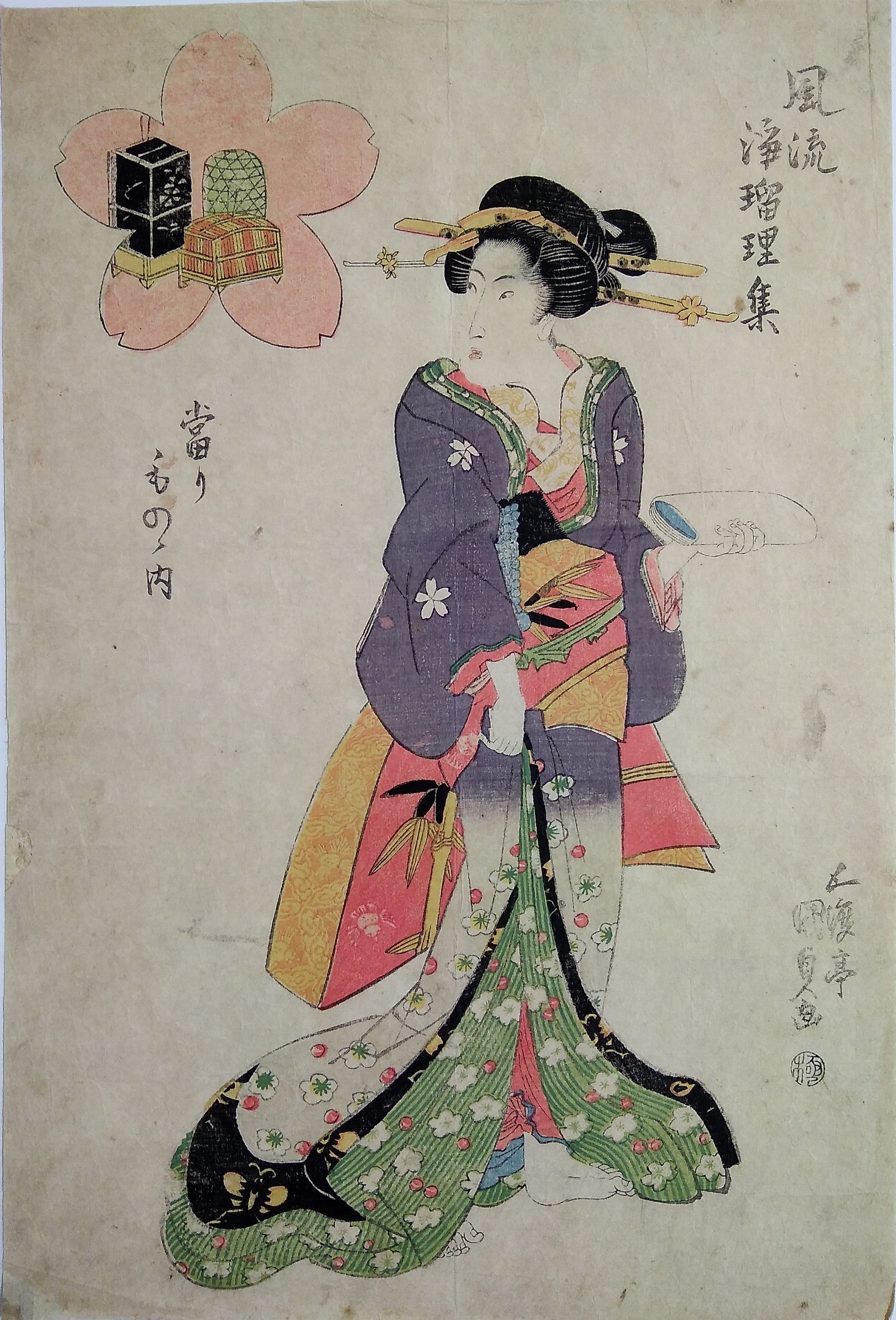 Sold Out
Sold Out
A beauty representative of the era may allude to the Tomimoto jōruri school.
The prominent cherry blossom in the upper left corner, which mirrors the pattern on the woman`s violet garment, could be a reference to the Tomimoto
family crest (kamon). Enclosed within is a set of three boxes, possibly alluding to a jōruri drama titled Mushikago or “Insect Cage.”
Jōruri, also known as Japanese puppet theatre, is a traditional musical storytelling art form in which a lead narrator, accompanied by a three-stringed lute
called a shamisen, uses vocal performance to convey emotion and narrative within the drama
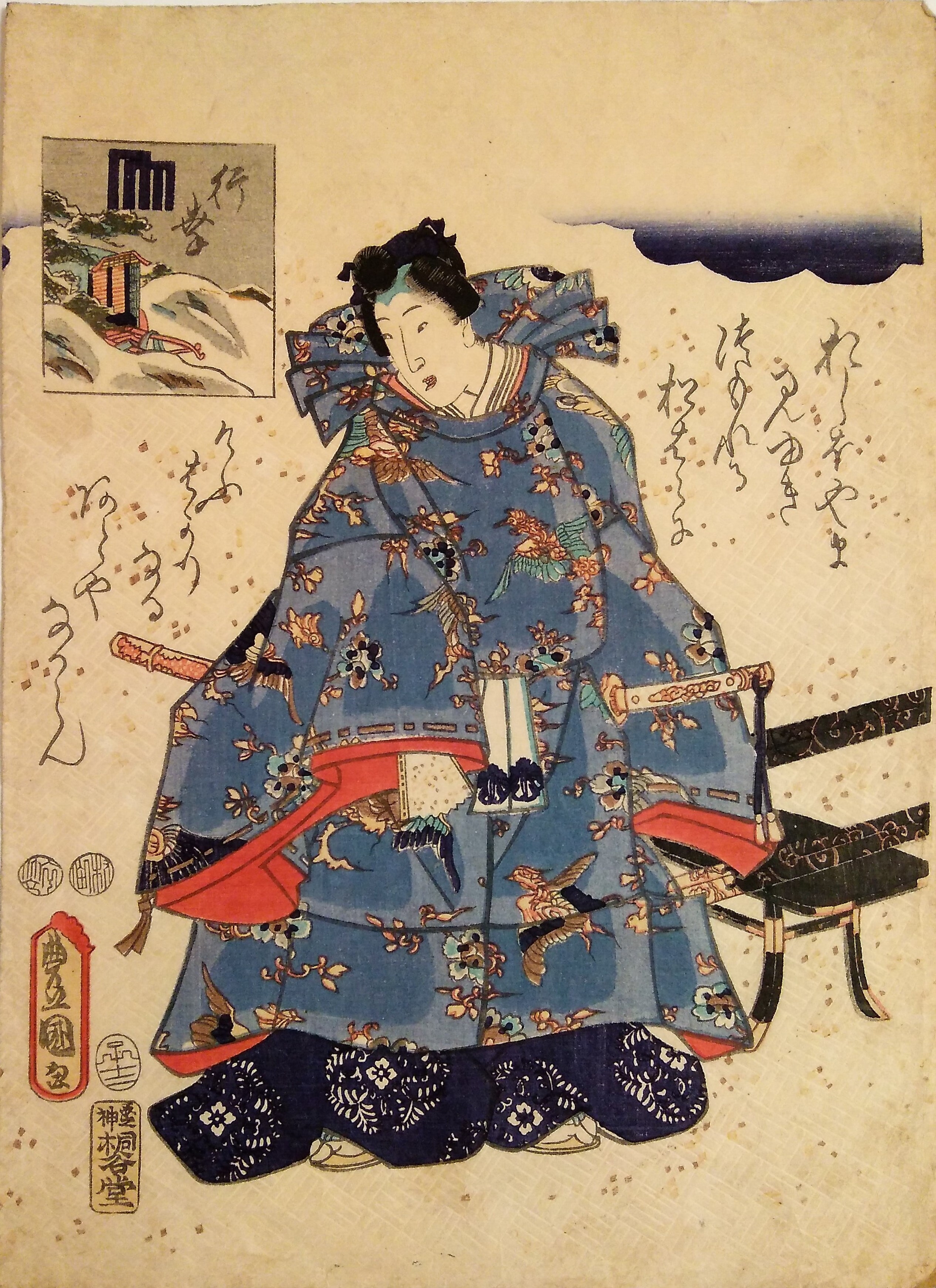 Sold Out
Sold Out
Miyuki is the twenty-ninth chapter from the famous Tale of Genji.
Here, Prince Genji stands in his rich and pompous formal attire. Behind him, a poem, shaped to resemble falling snow, spreads across the width of the paper.
"Oshioyama miyuki tsumoreru matsuhara ni kefu bakari naru ato yanakaran."
"小塩山みゆきつもれる松原に,今日ばかりなるあとやなからん。"
"Will there ever be another trace like today in the pine grove on Mount Oshio where the snow has piled up?"
The frame in the upper left corner provides an idea of what the poem is describing: a snow-covered pine grove and a palanquin, or chariot, commonly used by aristocracy during
their travels.
This edition is likely from the early 1860s, following the first release in 1852, where the publisher appears as Hamadaya.
The entire paper is embossed, creating a decorative background pattern.
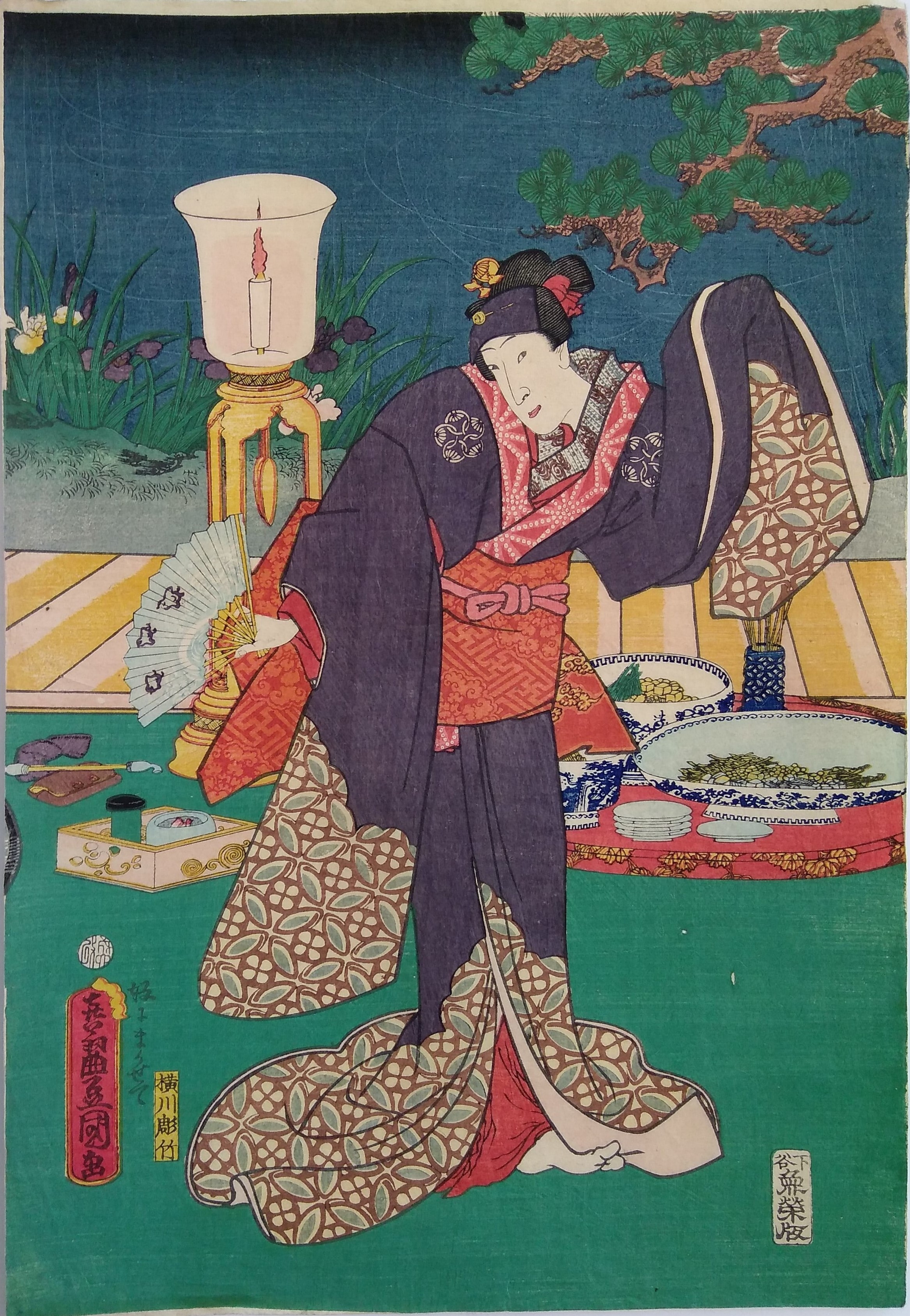 Sold Out
Sold Out
A geisha stands on a patio, acting and performing a dance for a group of customers during a banquet, as can be understood from the dishes placed on the tray in the background and the kiseru, a Japanese smoking pipe, on her left.
This print belong to a triptych: the customer she is entertaining are on her left, while her movements are actually accompained by the notes and the words played and recited by two other performers on the right. One is playing a samisen the other reciting a drama.
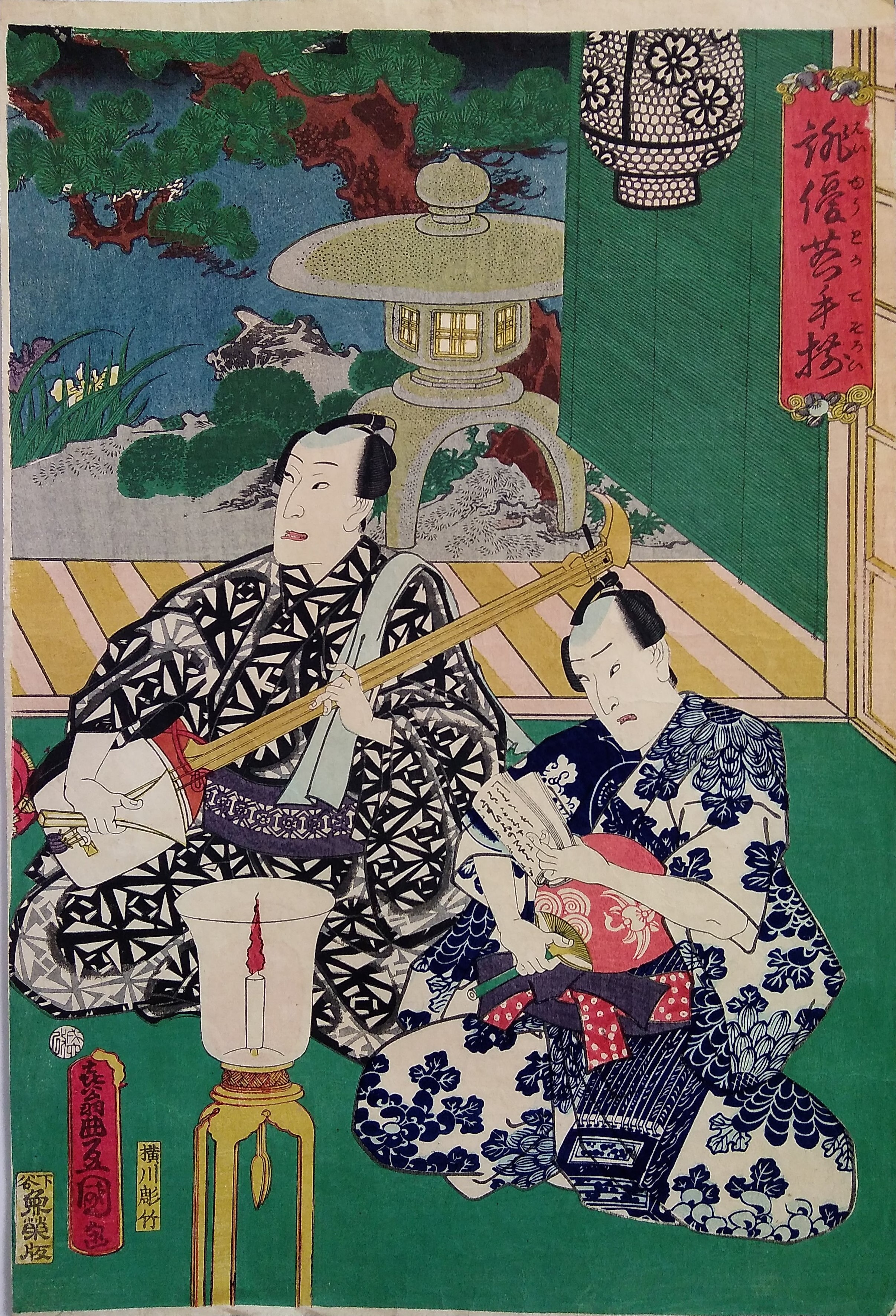 Sold Out
Sold Out
One of the prints from the "Gathering the arts: acting and reciting" triptych by Toyokuni III.
Here we have a couple of performer, one playing the samisen while the other reciting a drama. Their words and music create the atmosphere and the scenario in which another performer, a geisha, depicted on a second print acts and dances.
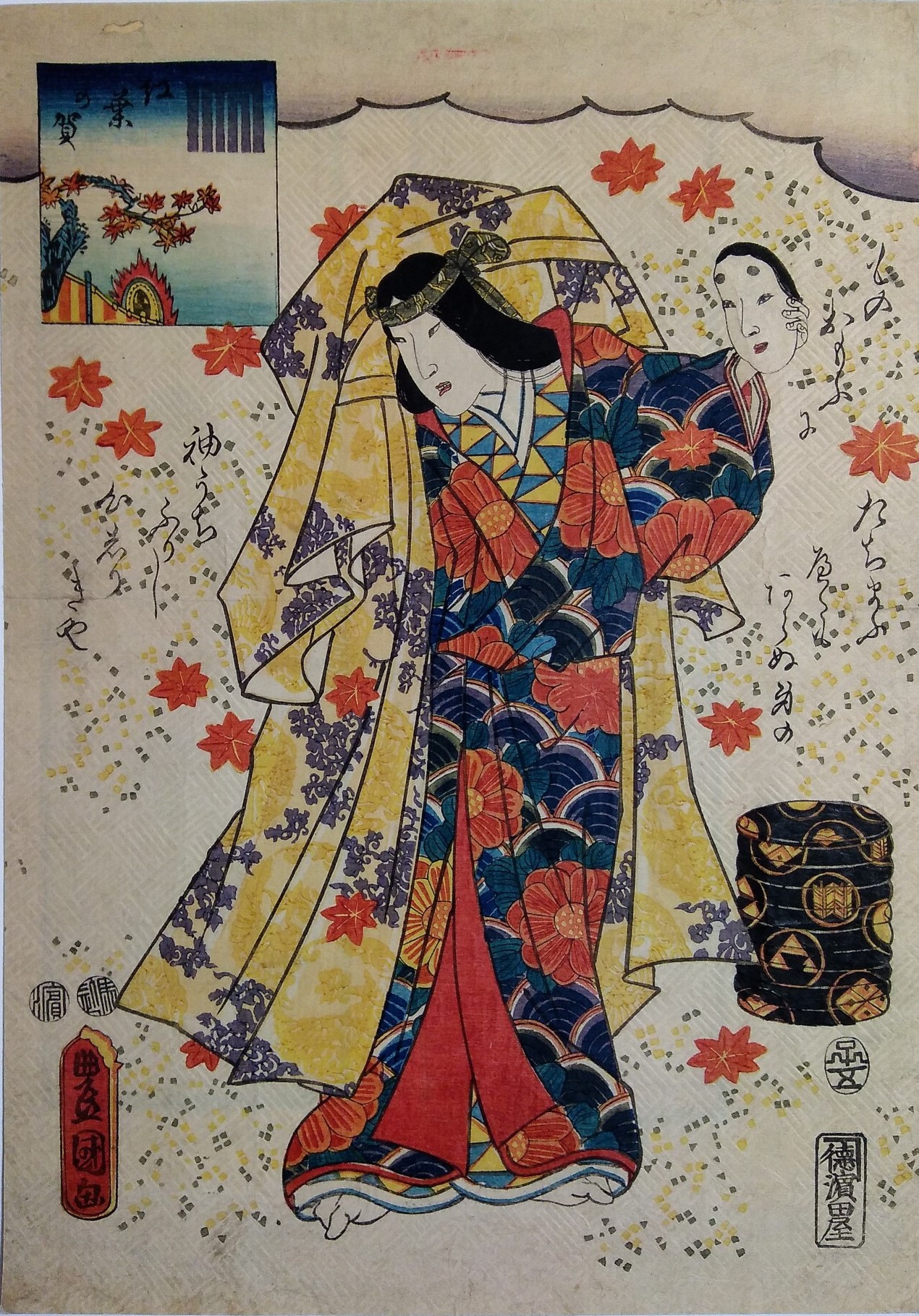 Sold Out
Sold Out
"Momiji no ga" is the seventh chapter from the famous Tale of Genji.
The Emperor`s nephew To no Chujō, friends but rival in love of prince Genji (both of them are having an affair with a lady in waiting), is dancing under a fall of red Autumn leaves (momiji) offering the court
a magnificent view.
"Mono omou ni, tachimaubeku mo, aranu ni no, sode uchifurushi, kokoro shiriki ya"
"ものおもふにたちまふやくもあらぬ身の袖うちふりし心しりきや)"
"Hunted by my thoughts I can`t even stand to dance, but when my sleeves waved did you understand the true emotions deep inside my whirling heart?".
In the upper left corner a square frames a branch covered in red autumn leaves, stressing the importance of the seasonal changing with its colors, flowers and trees as a pivotal leitmotif of the Japanese poetry.
The entire paper ha been embossed creating a nice background decoration pattern.
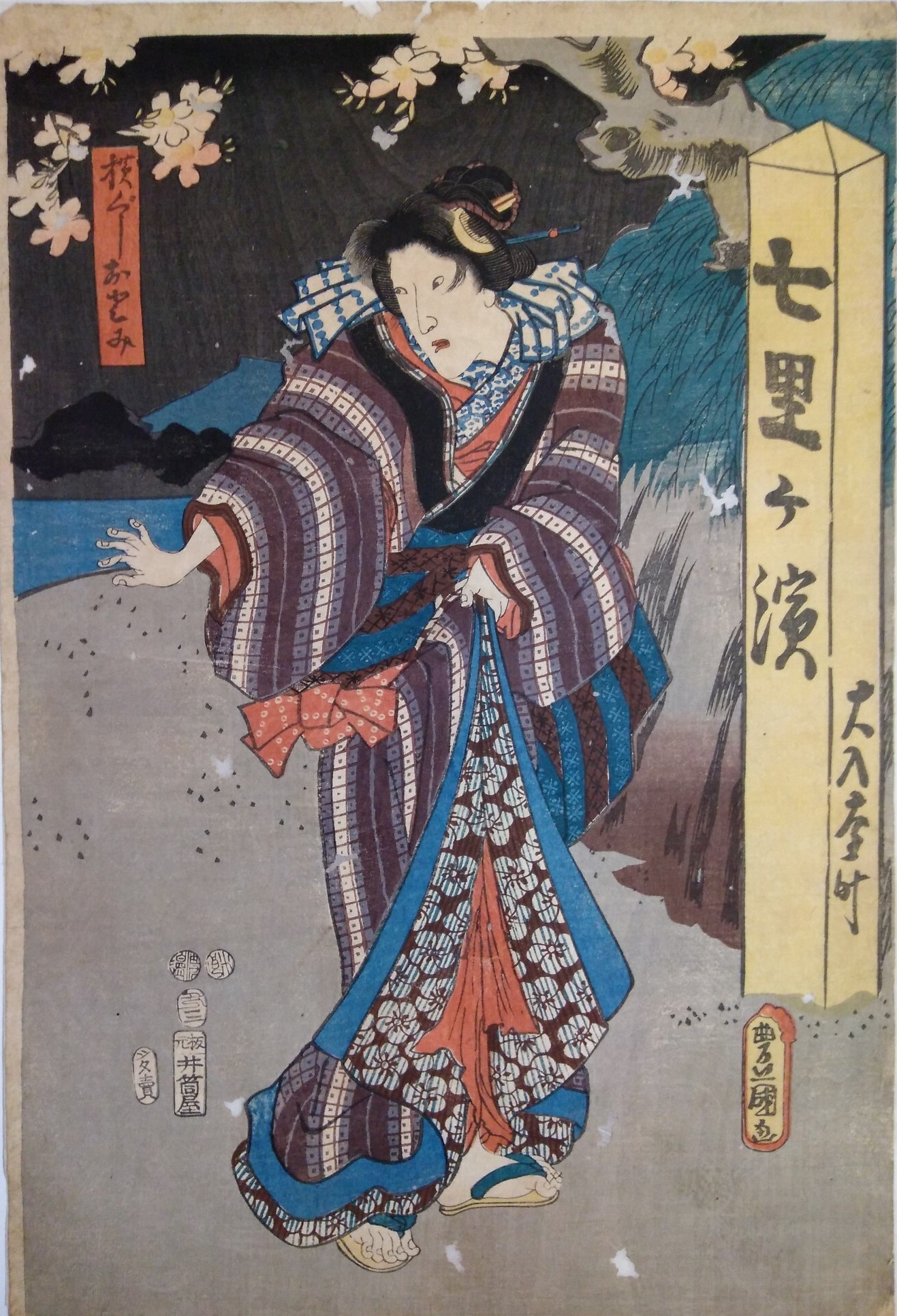 Sold Out
Sold Out
The kabuki actor Onoe Baikō IV playing as onnagata Yokogushi Otomi, a female characters from the kabuki drama Yoha nasake ukina no Yokogushi.
The play, popularly known as Otomi Yosaburō, was composed by Segawa Jokō III and performed for the first time on May 1853, at the Nakamura za theater in Edo.
 Sold Out
Sold Out
The kabuki actor Ichikawa Kodanji playing as Kuwanon Kiuji (or Kanon), a characters from the kabuki drama Yoha nasake ukina no Yokogushi.
The play, popularly known as Otomi Yosaburō, was composed by Segawa Jokō III and performed for the first time on May 1853, at the Nakamura za theater in Edo.
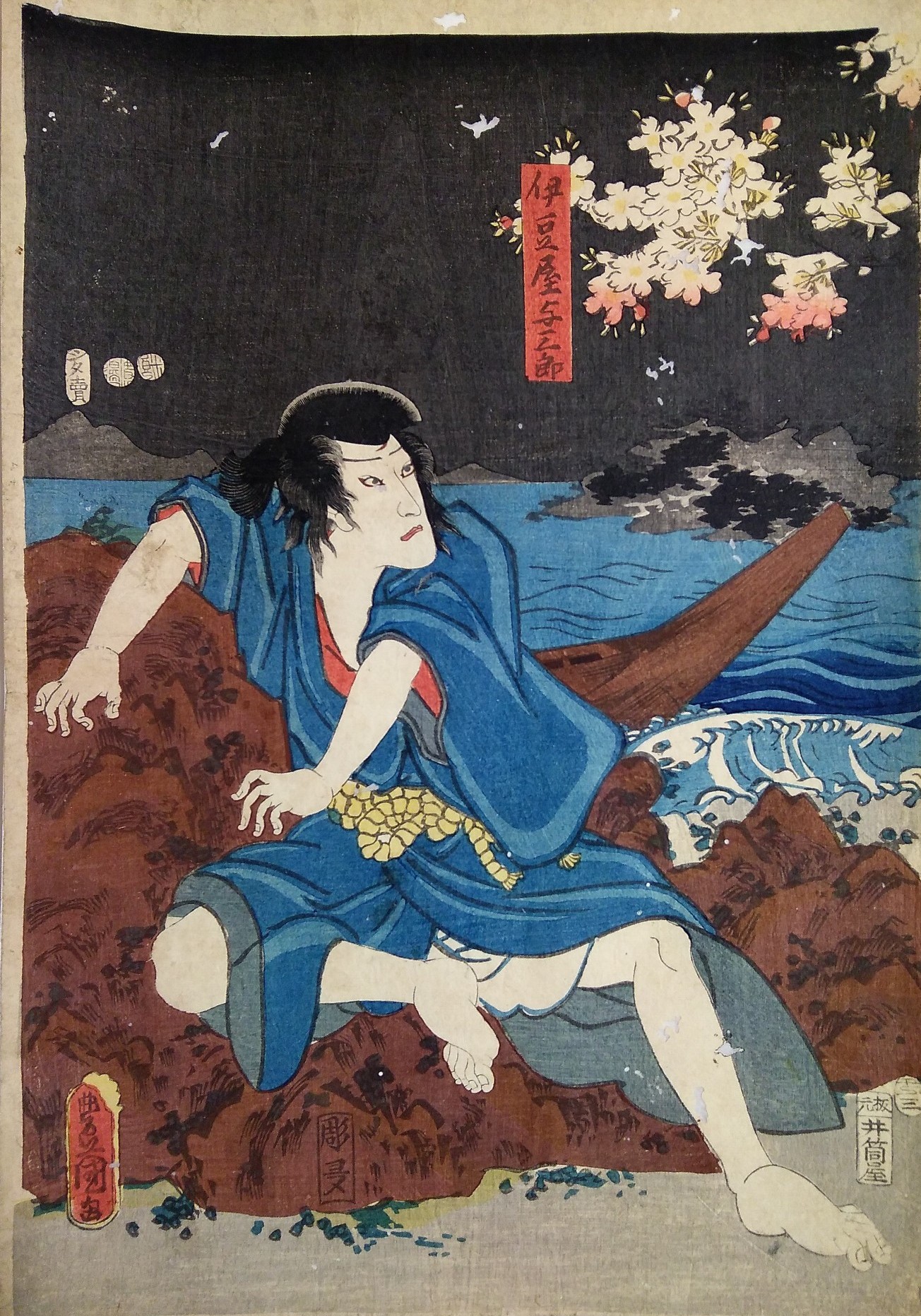 Sold Out
Sold Out
The kabuki actor Ichikawa Danjurō playing as Izuya Yosaburō, a characters from the kabuki drama Yoha nasake ukina no Yokogushi.
The play, popularly known as Otomi Yosaburō, was composed by Segawa Jokō III and performed for the first time on May 1853, at the Nakamura za theater in Edo.
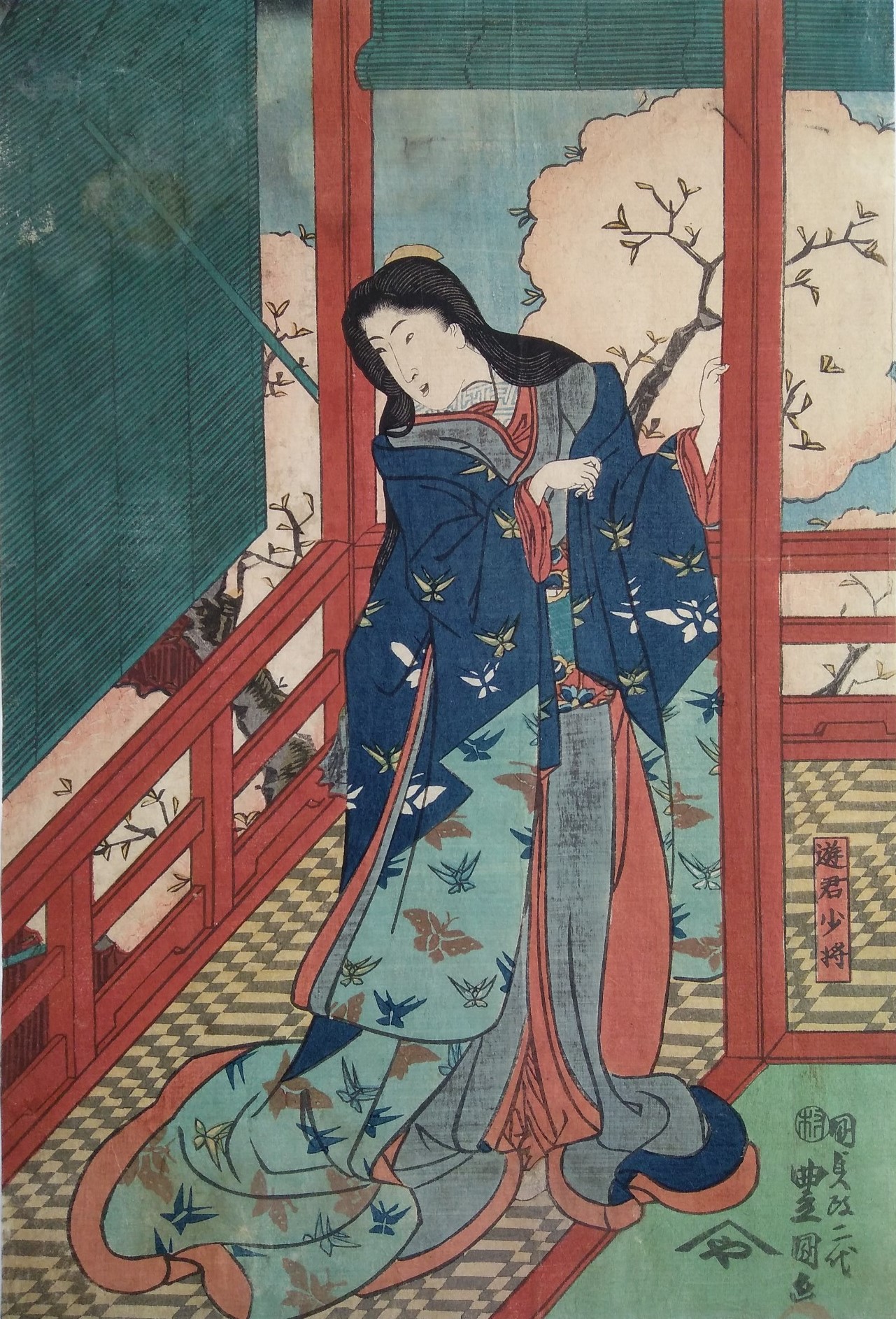 Sold Out
Sold Out
Central print from a triptych dedicated to the Tale of the Soga, showing the courtesan Kewaizaka no Shōshō, who was in love with Tokimune.
The tale of the Soga (Soga monogatari) is an epic tale belonging to the war tales genre (gunki monogatari) and generally considered the last of them.
It tells about the act of revenge performed by the two Soga brothers, the elder Sukenari and the younger Tokimune against Kudō Suketsune, who had killed their biological father years before,
seemingly because of an argument over land right.
The matter took place on June 28,th 1193, during a grand hunting event called Fuji no Makigari held by the Shōgun Minamoto no Yoritomo at the foot of Mount Fuji where, it is said, almost 700.000
participants were invited.
After that Suketsune was killed Sukenari was eventually shot by one of Suketsune`s retainers; Tokimune was stopped only after having reached the Shōgun chamber, then questioned and finally executed.
Alongside the revenge of 47 rōnin is among the most famous vendetta incidents of Japanese history.

A print depicting the Kabuki actor Nakamura Shikan IV playing the role of Nangō Rikimaru, from the famous kabuki play Aoto Zōshi Hana no Nishikie written by Kawatake Mokuami and performed
for the first time in March 1862 at the Ichimura Za of Edo.
The play is widely known under different names as Benten Kozō, which refers to the main character of the play or as Shiranami Gonin Otoko ("Five men of the white waves”, were white waves is a term used to indicate thieves).
The play took as pivotal characters a band of five thieves that actually really existed in Osaka during the Edo period.
Nangō Rikimaru appears as Benten Kozō`s retainer since the first act of the play, before the gathering of the band of five.
USD$ 114.00
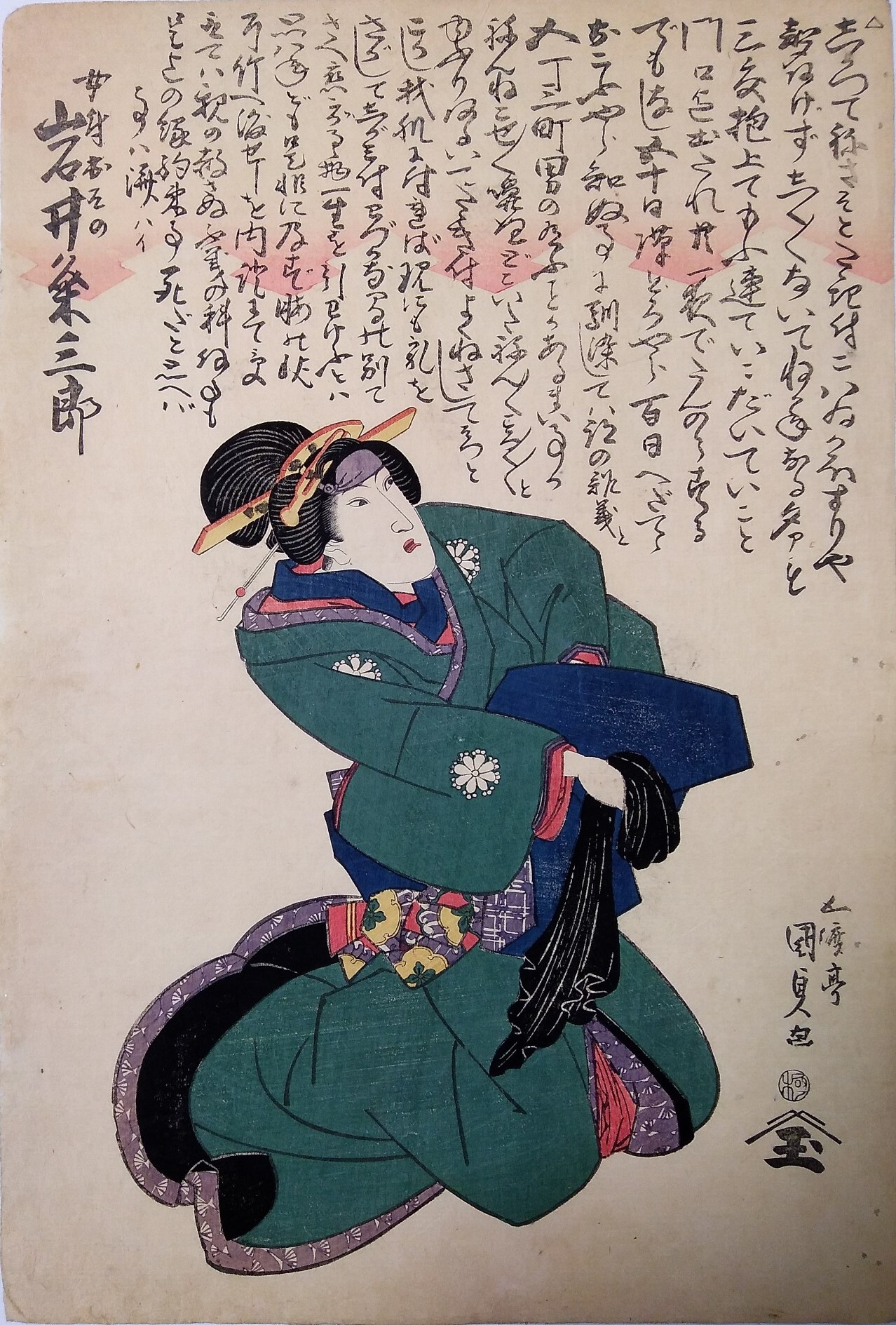 Not for Sale
Not for Sale
The Kabuki actor Iwai Kumesaburō playing as onnagata the role of Nyōbō Osono. From the play Okuniiri Soga Nakamura performed for the first time in 1825 a the Nakamura theater (nakamura za) of Edo.
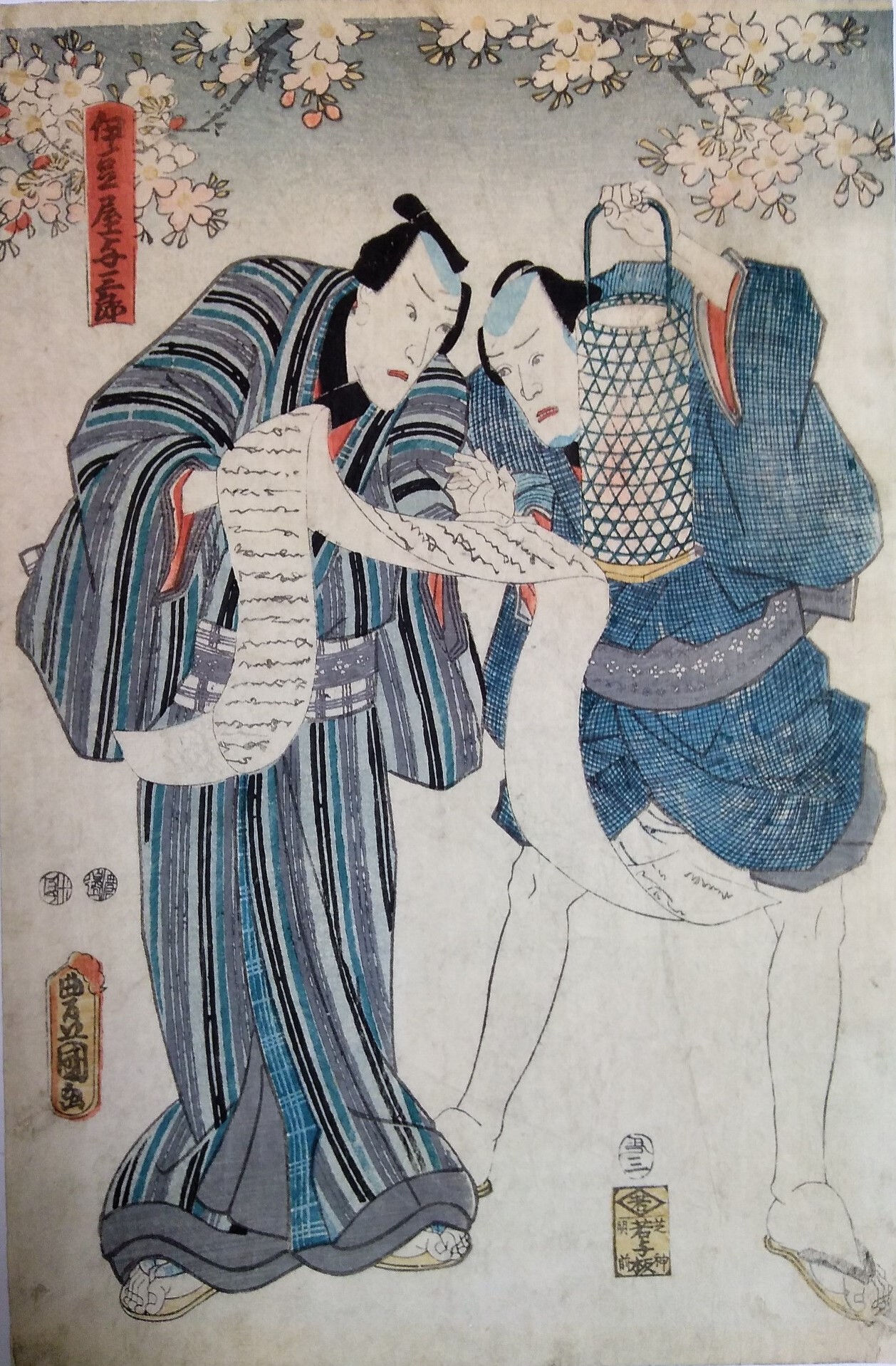
In this print taken from a scene of a kabuki drama named Yoha nasake ukina no Yokogushi the kabuki actor Ichikawa Danjūrō VIII on the left and Nakamura Aizō I (or Nakamura Fukusuke I) on the right are
reading a letter together.
The Yoha nasake ukina no Yokogushi is a popular drama where a man and a woman which where lovers in their youth, got apart and respectively believed to be dead meet again as adult. The man has fallen into disgrace while
the woman has been living a refined life since. They seem to get close again, as they where in the past, but there seems to be no future for their destinies to be together, being incapable of leave each other but hindered
by an averse fate at the same time.
USD$ 134.00

The kabuki actor Iwai Hanshirō performing a kabuki dance as onnagata, a male actor playing a feminine role.
USD$ 230.00

The Kabuki actor Sawamura Tanosuke playing the role of the courtesan Iroha from the Kana tea house.
The subject is probably taken from a sewamono (kabuki drama about commoners and ordinary people) of the late 18th century written by Takeda Haruzō, a dramatic love story known as "Kane ga naru kesa no uwasa" (A morning rumor rings the bell).
Inside the brownish cartouche that spreads along the right border of the print there is a poem that says:
"土用芽は薄き色葉のもみぢ哉"
"Doyōme ha usuki iroha no momiji kana"
"Are the midsummer sprouts autumn leaves of light colour?"
USD$ 181.00
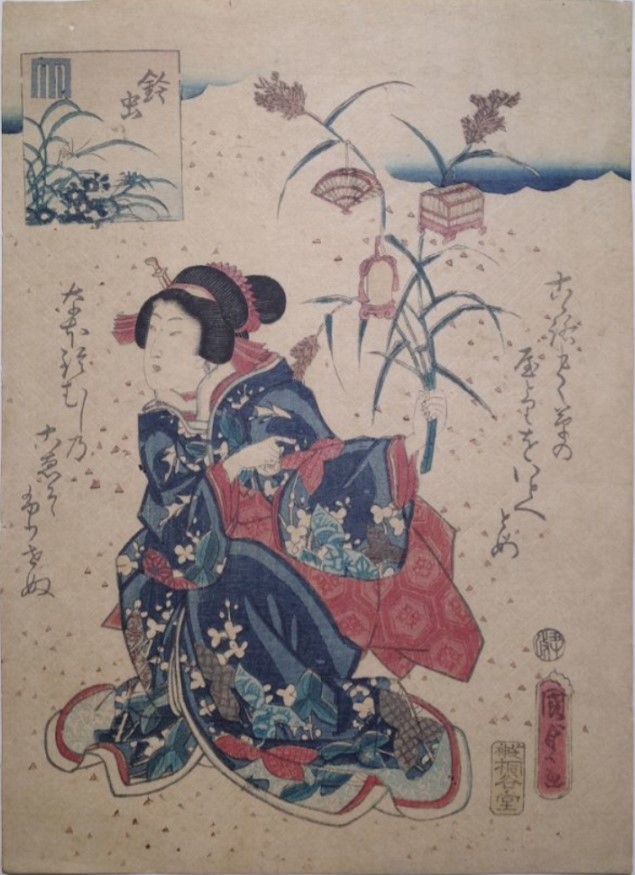
Suzumushi, or bell cricket, is the thirty eigth chapter from the famous Tale of Genji.
The chapter`s name is aptly represented by the slender bell cricket crawling through the grass, enclosed within the square cartouche in the upper left corner.
Here is a summary of the chapter:
Beginning her monastic life, Nyosan consecrates Buddha Amida`s images for her chapel. Since she has taken her vows, Genji finds his affection for the young princess growing, lamenting the loss of her company.
On a visit, he spontaneously performs a koto concert, with Sochi no Miya and Yugiri joining in. During this time, a messenger delivers a letter from Ryozen to Genji, urging him to come. Their meetings had been infrequent following the former emperor`s abdication.
Before departing from the retired emperor`s dwelling, Genji seeks out Akikonomu, who reveals her wish to become a nun to repent for her mother`s wrongs, having discovered Murasaki was possessed by Rokujo. Genji, however, advises against it, suggesting she pray for the
late spirit instead.
USD$ 121.00

Asagao, or Japanese morning glory, is the thirty eigth chapter from the famous Tale of Genji.
The chapter`s name is aptly represented by the flowers enclosed within the square cartouche in the upper left corner.
Here is a summary of the chapter:
Following Prince Momozono`s death, Asagao exits her Vestal role at Kamo and returns to the Capital, residing with her father and Aunt Nyogo. Genji seizes this chance to approach the Lady he admires,
but she remains distant, only responding with brief verses, urged by her servants.
Genji`s visits to his aging aunt remind him of life`s fragility; at Momozono Palace, he meets the once affectionate, now aged Lady-in-Waiting, still lively, which deepens his regret for the more accomplished
and prematurely deceased Fujitsubo.
Despite rumors at court suggesting a bond with Asagao, leading to Murasaki`s insecurity, Asagao stands firm against Genji`s advances, considering monastic vows.
In a dream, Fujitsubo chastises Genji for his past sins affecting her afterlife. Shaken, Genji prays for her soul, hoping for redemption.
USD$ 121.00

Akane Hanshichi (赤根半七) is a historical Japanese character from the Edo period, famous for a dramatic love story with Sankatsu, a woman tied to the theater world and the nightlife of Osaka.
This tragic narration of love, honor, and tragedy, set precisely in 1695, has inspired numerous theatrical works in Kabuki and Bunraku, the Japanese puppet theater.
Hanshichi, the son of a dyer named Hanbei and initially married to another woman, falls deeply in love with Sankatsu. From their relationship, even a child is born, but their story is destined to take a tragic turn
due to a murder committed by Hanshichi, pushing them towards a desperate end.
They decide to commit double suicide at the Sen`nyū-ji cemetery in Osaka, tying themselves together with a piece of red silk cloth and cutting their throats, an event that captured the imagination of the audience of
the time and continues to be appreciated for its deep reflection on universal themes such as fidelity, sacrifice, and guilt.
Their story unfolds through a series of dramatic events that highlight the complexities of human relationships and the inevitable conflict between social duty and personal desire, culminating in the tragic decision to
end their lives in a final act of love and despair.
The figure of Sankatsu, especially in the work En`yō Onna Mai-ginu, has become a popular subject in Japanese culture, revisited in multiple art forms and considered a classic example of monogatari (tale) linked to personal
tragedies within sentimental relationships of the Edo period. The author`s ability to weave elements of drama into a moving story has ensured this narration a prominent place in the Japanese theatrical tradition, influencing
subsequent representations and vividly reflecting the cultural and social context of the time.
USD$ 139.00
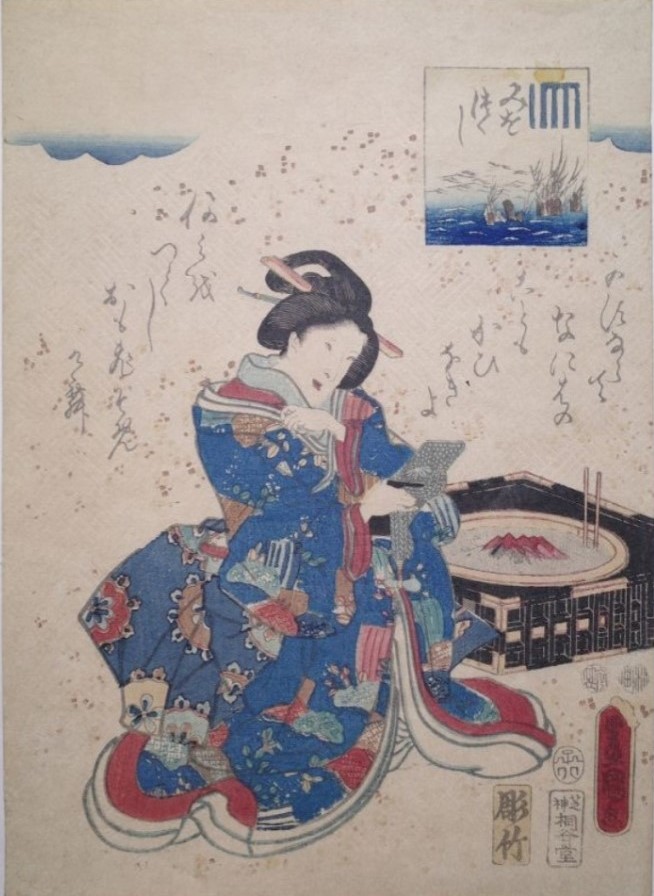
Mi o Tsukushi is the fourteenth chapter from the famous Tale of Genji.
Follows an approximate translation of the poetic text that appears on background to the lady depicted in the work, and a summary of the chapter.
"かすならてなにはのこともかひなきよあみをつくしおもひそめけむ。"
"Kasunara te naniwa no koto mo kai naki yo ami wo tsukushi omoi someshi kemu."
"Since it seemed futile, I have spent all my efforts in vain, accumulating useless thoughts."
Genji regains the prestige lost due to his exile and becomes a Palace Advisor, while Aoi`s father, his father-in-law, returns to politics as the Prime Minister.
The Emperor abdicates in favor of Fujitsubo`s son, and the title of Rightful Heir goes to Suzaku`s son.
Genji plans to restore a pavilion for the ladies and learns that the Lady of Akashi has given birth to a future empress, a decision that stirs jealousy in Murasaki, Genji`s favorite.
After generous gifts for the Fiftieth Day from the birth of the girl, Genji visits the Lady of the Falling Flowers Village and Fujitsubo, now the Empress Mother. Hyobukyo, who had despised him during the exile,
fails to regain his esteem.
A pilgrimage and a coincidental meeting with the Lady of Akashi further strengthen their bond.
With Rokujo`s death, Genji promises to care for her daughter without seducing her, despite the temptation.
The retired emperor Suzaku wants Akikonomu at court to influence the new young emperor, but Genji, supported by Fujitsubo, already has plans to present her at court as a guide for the sovereign.
USD$ 129.00

Genji is in an advantageous position without opponents, having delegated many responsibilities to To no Chujo. Tamakatsura, troubled after a confession from Genji, continues to distrust him despite his remorseful and fatherly behavior.
Genji encourages the young woman to meet Sochi no Miya, but she shows no interest, and Sochi no Miya leaves the palace disappointed.
During an event at the residence of the Lady of the Village of Falling Flowers, Genji and the lady discuss other nobles, with her showing interest in Sochi no Miya and Higekuro. The lady leaves Genji alone for the night, despite his willingness to stay.
During the rainy season, the women remain indoors reading and copying stories. Genji finds Tamakatsura reading and starts a discussion about literature. Murasaki, also passionate about literature, is encouraged by Genji not to share immoral stories with Princess Akashi.
Yugiri often visits his half-sister, recalling past times with Kumoi, whom he couldn`t marry. This reignites a rivalry with Kashiwagi, similar to that between their fathers. To no Chujo, father of many children, continues to reflect on the loss of Yuugao, unaware that
Tamakatsura is his daughter.
On the background a poem from the chapter:
"Koehasete mi wo nomi kogasu hotarukoso ifuyori masaru omohinaru rame."
"こゑはせて身をのみ焦かす蛍こそいふよりまさる思ひなるらめ。"
"The unspoken love of the burning firefly is deeper than the words you spoke out."
USD$ 123.00

This print dedicated to the "Tale of Genji" depicts a a noblewoman dressed in an intricate, floral kimono. Her elegant posture and the tranquil indoor setting emphasize a moment of intimate reflection, characteristic of Heian period literary themes.
This chapter opens with Akikonomu`s court presentation, marked by elegance as Genji supports her silently with gifts despite her engagement to another. Ryozen`s interest in painting leads to a court rivalry between Akikonomu and another lady, with both sides seeking to impress with their artwork.
Genji aids Akikonomu with valuable pieces from his collection, eventually helping her win a painting competition at court.
The chapter explores themes of artistic rivalry, support, and the continuing impact of past relationships on Genji`s emotional landscape.
On the background a poem from the chapter:
"Ukime mite sono ori yori mo kyou wa mata suki ni shikata ni kaeru namida ka."
"うきめ見てその折りよりもけふはまたすきにしかたにかへるなみだか。"
"Having seen sorrow, today again, more than that time, tears return to their natural path."
USD$ 143.00

